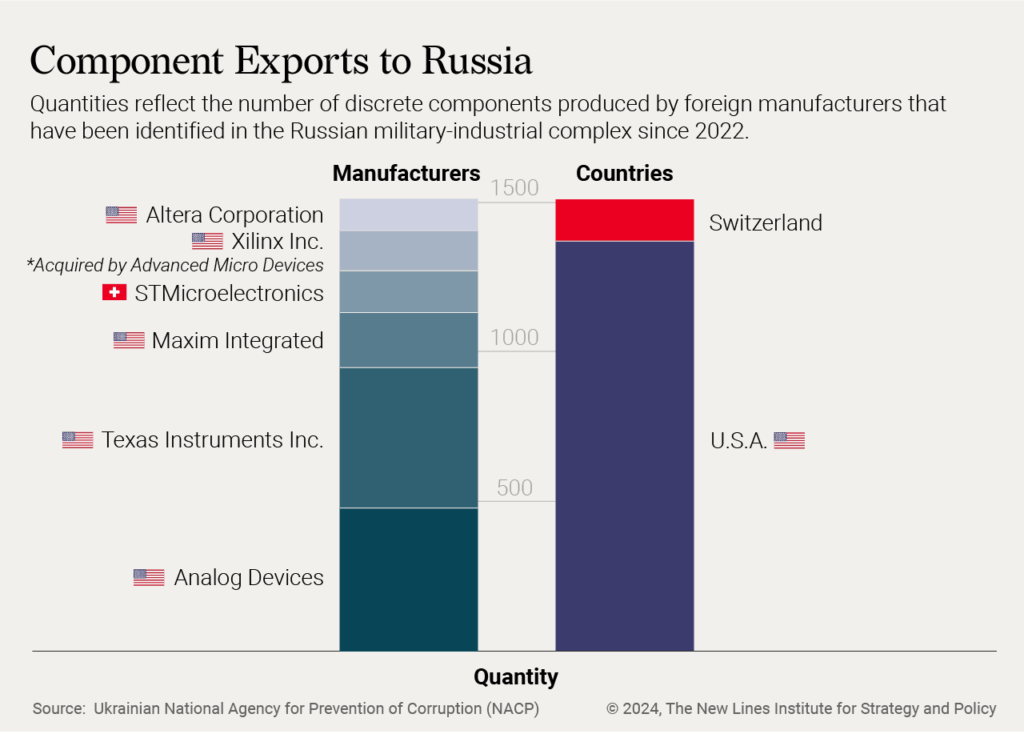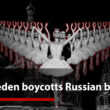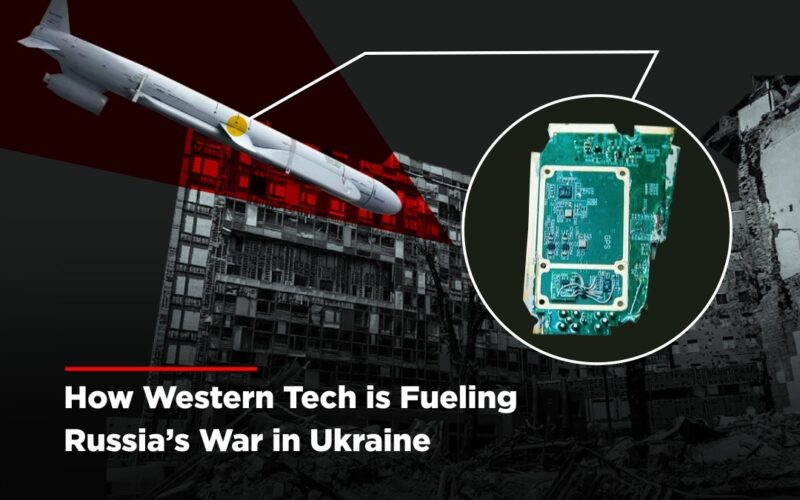As Russia continues its war against Ukraine, Western technology is playing an unsettling role in the conflict. Despite sanctions imposed by the U.S., the European Union, and their allies, critical components produced by Western companies are regularly found in Russian missiles targeting Ukrainian hospitals. This highlights a major flaw in the sanctions regime — loopholes that allow Russia to circumvent export restrictions and acquire key technologies. To address this, the West must urgently develop more effective mechanisms for identifying and closing these loopholes, as well as punishing companies complicit in enabling Russia’s war machine.
The Kh-101 Missile: A Case Study in Sanctions Evasion
One of the most glaring examples of how Western technology is aiding Russia’s military is the Kh-101 cruise missile, a key weapon in the Kremlin’s arsenal. On July 8, 2024, a Kh-101 missile struck Kyiv’s Okmatdyt pediatric hospital, Ukraine’s largest children’s medical facility, wounding over 100 people and killing 47 across the city. Open-source video evidence and debris recovered by Ukrainian security forces confirmed that a Kh-101 was responsible. The missile contained at least 18 U.S.-made components, along with 10 others from European manufacturers.
Russia cannot produce these high-precision munitions without relying on foreign-made microchips and other components, most of which it acquires through third-party countries that act as intermediaries. These parts, including advanced microprocessors and semiconductors, are essential for the guidance systems that allow Russian missiles to strike their targets with deadly accuracy.
How Do These Components End Up in Russian Missiles?
Despite the sanctions introduced after Russia’s full-scale invasion of Ukraine in 2022, the Kremlin continues to source these components through a complex network of intermediaries. Companies like Texas Instruments and Analog Devices manufacture microchips that find their way into Russian missiles via “front companies” in third countries, including China, Malaysia, Turkey, and the United Arab Emirates. These middlemen purchase the technology legally and resell it to Russia, circumventing direct bans on sales.
Texas Instruments, for example, manufactured 51 of the 450 Western-made components found in Russian weapons systems used in Ukraine. In 2022 alone, Russia received over $50 million worth of Texas Instruments components, despite U.S. sanctions. Analog Devices also plays a significant role, with $89 million worth of technology sold to Russian intermediaries over the same period.

Western-Made Components Fuel Russian War Crimes
These technologies have devastating consequences. In addition to the Okmatdyt hospital attack, Russia has used Western-made components in missiles to target civilian infrastructure across Ukraine. For instance, the 3M-14E Kalibr cruise missile, which killed 27 civilians in Vinnytsia in July 2022, and the 9M727 Iskander missile used in Chernihiv in August 2023 both contained microchips from U.S. companies.
The World Health Organization has recorded more than 1,300 attacks on healthcare facilities in Ukraine since the war began, 60% of which occurred in 2024. Such attacks are not isolated incidents; they are part of a deliberate Russian strategy to cripple Ukraine’s healthcare infrastructure, much like Russia’s tactics in Syria. Hospitals, clinics, and civilian medical centers are prime targets, and their destruction is facilitated by foreign-made technology.
The Inefficiencies of the Current Sanctions Regime
The U.S. and EU sanctions currently in place are riddled with loopholes that Russia exploits to keep its military well-supplied with critical components. The sanctions primarily target high-tech components, but many older technologies — which are still effective for missile guidance systems — remain outside their scope. Furthermore, enforcement is weak. Microchips are small, easy to smuggle, and often fall outside the radar of export control agencies.
In 2023, over 17,000 Texas Instruments microchips were exported to Russia via intermediaries, including two Hong Kong-based companies now under U.S. sanctions. While the company claims these sales occurred before sanctions took effect, the continued flow of technology into Russia illustrates the need for more robust oversight. Western companies profiting from these loopholes are benefiting from the same taxpayer money that funds air defense systems, such as Patriot and NASAMS, intended to protect Ukraine from Russian missiles.
The Path Forward: Stricter Enforcement and Sanctions Reform
To effectively choke off Russia’s access to Western-made components, the U.S., EU, and their allies must reform their sanctions policies. Here are several key steps that should be taken:
- Strengthen Identification Mechanisms: Governments must enhance their ability to track where their technology ends up. This includes developing new systems for monitoring supply chains and preventing sanctioned goods from reaching third-party intermediaries. Export controls need to be more comprehensive and cover older, lower-tech components that Russia still uses in its missiles.
- Punish Companies Complicit in Sanctions Evasion: While many companies claim they do not knowingly sell to Russia, they must take responsibility for their supply chains. Firms like Texas Instruments and Analog Devices should face heavier fines, penalties, or even criminal charges if their technology ends up in Russian missiles. Additionally, the U.S. and EU should implement secondary sanctions on countries and entities that act as intermediaries.
- Close Loopholes and Tighten Export Controls: The U.S. Commerce Department’s Bureau of Industry and Security must expand its export control rules, particularly the Foreign Direct Product Rule (FDPR), to cover a wider range of goods and technologies. Sanctions should include components considered “low-tech,” which are still crucial for Russia’s military capabilities.
- Increase Global Coordination: Western allies must improve their coordination in enforcing sanctions. A revised version of the Coordinating Committee for Multilateral Export Controls (CoCom), a Cold War-era body that limited technology exports to the Soviet bloc, should be re-established. This new body would work closely with NATO members and other strategic partners to prevent technology transfers to Russia through third-party states.
- Enhance Whistleblower Protections: Governments should strengthen whistleblower protections to encourage insiders to come forward with information about sanctions evasion. The Anti-Money Laundering Whistleblower Improvement Act, passed in 2022, provides financial incentives for individuals to report violations, but similar laws focused on sanctions evasion would be a powerful tool.
Conclusion: Sanctions Need Teeth to Protect Ukrainian Lives
The ongoing flow of Western technology into Russia’s military highlights the inadequacies of the current sanctions regime. Unless these loopholes are closed, and companies held accountable, Ukrainian civilians — including children in hospitals — will continue to be the targets of Russian missile strikes. The U.S., EU, and their allies must take decisive action to strengthen sanctions, improve enforcement mechanisms, and ensure that no company profits from the bloodshed in Ukraine.








